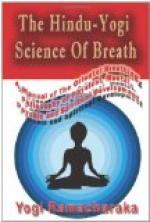This is a very important exercise which tends to strengthen and develop the respiratory muscles as well as the lungs, and its frequent practice will also tend to expand the chest. The Yogis have found that an occasional holding of the breath, after the lungs have been filled with the Complete Breath, is very beneficial, not only to the respiratory organs but to the organs of nutrition, the nervous system and the blood itself. They have found that an occasional holding of the breath tends to purify the air which has remained in the lungs from former inhalations, and to more fully oxygenate the blood. They also know that the breath so retained gathers up all the waste matter, and when the breath is expelled it carries with it the effete matter of the system, and cleanses the lungs just as a purgative does the bowels. The Yogis recommend this exercise for various disorders of the stomach, liver and blood, and also find that it frequently relieves bad breath, which often arises from poorly ventilated lungs. We recommend students to pay considerable attention to this exercise, as it has great merits. The following directions will give you a clear idea of the exercise:
(1) Stand erect.
(2) Inhale a Complete Breath.
(3) Retain the air as long as you can comfortably.
(4) Exhale vigorously through the open mouth.
(5) Practice the Cleansing Breath.
At first you will be able to retain the breath only a short time, but a little practice will also show a great improvement. Time yourself with a watch if you wish to note your progress.
(2) Lung cell stimulation.
This exercise is designed to stimulate the air cells in the lungs, but beginners must not overdo it, and in no case should it be indulged in too vigorously. Some may find a slight dizziness resulting from the first few trials, in which case let them walk around a little and discontinue the exercise for a while.
(1) Stand erect, with hands at sides.
(2) Breathe in very slowly and gradually.
(3) While inhaling,
gently tap the chest with the finger
tips, constantly changing
position.
(4) When the lungs are
filled, retain the breath and pat the
chest with the palms
of the hands.
(5) Practice the Cleansing Breath.
This exercise is very bracing and stimulating to the whole body, and is a well-known Yogi practice. Many of the air cells of the lungs become inactive by reason of incomplete breathing, and often become almost atrophied. One who has practiced imperfect breathing for years will find it not so easy to stimulate all these ill-used air cells into activity all at once by the Complete Breath, but this exercise will do much toward bringing about the desired result, and is worth study and practice.
(3) Rib stretching.




